As early as the 18th century, visitors to Egyptian tombs wanted to retransmit to their contemporaries the scenes they had been able to see. How did we go from often naive drawings to the exceptional photographs of today? 4th episode of the Egyptian notebooks.
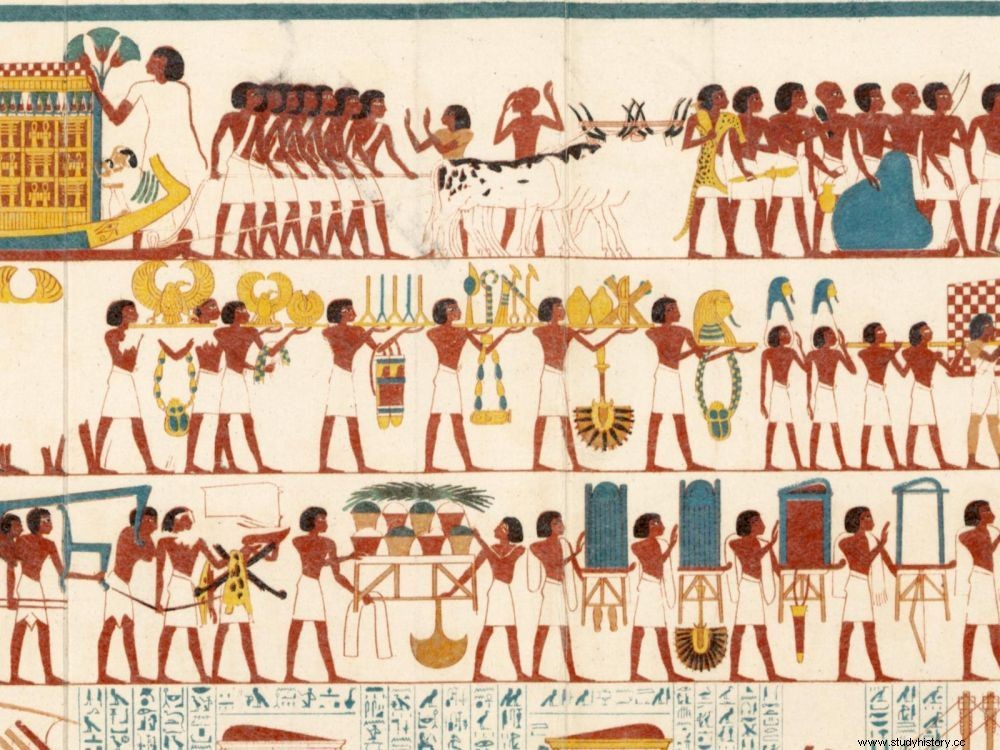
Funeral of a royal scribe, John Gardiner Wilkinson
In the 18th century, in the absence of photography, visitors had to be content with more or less happiness to publish often naive drawings, through engravings which often hardened the line. These works of art are then only perceived as historical documents making it possible to identify the habits and customs of the ancient Egyptians. During the Egyptian campaign of 1798, Bonaparte was accompanied not only by scholars but also by architects and artists. The Description of Egypt delivers a monumental sum of hundreds of elegant engraved plates. They were nevertheless drawn up by designers whose aesthetics were shaped by the observation of a beautiful ancient, classical and Greco-Roman. If they are precious to us when they represent unfortunately disappeared monuments, it is not possible to hope to find there the faithful image of what the Egyptian artist wished to create.
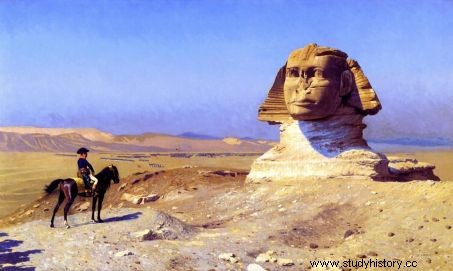
Jean-Léon-Gérome-Oedipus-Napoleon before the sphinx 1886 ©Wikimedia
From 1845, the Prussian expedition led by Richard Lepsius took with it a camera and countless silver plates. Unfortunately, they will not survive the return trip.
Notebooks of Egypt, 1st episode:how did the painters of ancient Egypt work?
Notebooks from Egypt, 2nd episode:Discovering the funeral chapel of Nakhtamon.
Notebooks from Egypt, 3rd episode:The pigments of Egyptian painting.
Notebooks from Egypt, 4th episode:The modern documentation of painted walls.
Notebooks from Egypt, 5th episode:Rediscovering the monuments of eternity of Ramses II.
Notebooks from Egypt, 6th episode:Revealing pigments with light:the visible and the invisible.
Notebooks from Egypt, 7th episode:Experiencing research through images.
Notebooks of Egypt, 8th episode:Beginning of the study of the paintings of the tomb of Nebamon and Ipouky.
But this new process of reproduction will be used in an intense and repetitive way to show an eager public the riches of an exotic Orient made powerfully romantic by modern painters labeled as Orientalists.
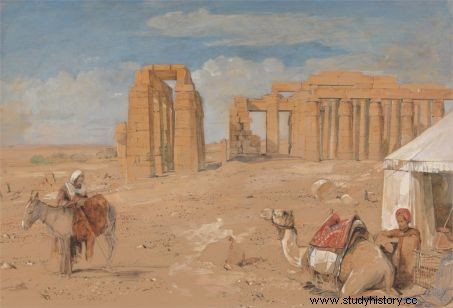
John Frederick Lewis – The Ramesseum at Thebes, Yale British Art Collection ©Google Art Project
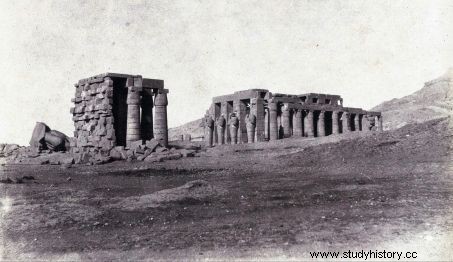
Francis Frith Ramesseum Thebes Egypt circa 1857
Egyptology did not remain outdone, but until the 1960s, alongside copies made in the form of drawings, Egyptian painting was often only rendered by black and white photographs which still continued to be published for reasons of economy. The transition to digital photography over the past thirty years and the continuous progress of this technique have made it possible to access increasingly accurate readings that are more easily disseminated to scientists and the general public.
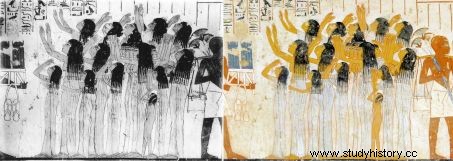
Painted wall of the tomb of Vizier Ramosé. Black and white publication from 1941 compared to a recent digital survey ©MAFTO / LAMS CNRS.
"Faithful representations of very high resolution and 3D are made today"
Today, our team uses optical documentation techniques on a daily basis such as digital photogrammetry and gigapixel imagery, which make it possible to obtain both very high resolution faithful representations and the three-dimensional model of the walls and the whole. of the tomb being studied:it becomes possible to auscultate funerary monuments by virtually stripping them of their painted decoration to understand their construction and conservation. These innovative documents subsequently allow a visual inspection of the monument on a computer, easier than on site, offering unique and lasting access to fragile monuments which have great difficulty in withstanding the passage of time and tourist pressure, while remaining not easily accessible to the general public.
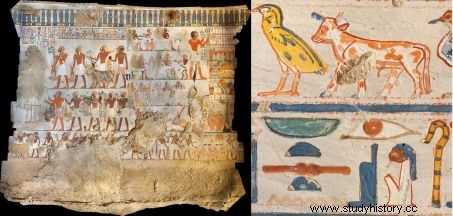
Gigapixel image of a wall of the Paser tomb and detail of hieroglyphic signs, a few centimeters high ©CEDAE – MAFTO/LAMS CNRS
"Between dream and reality, emotion is always strong alongside technology"
Member of the research team and Professor of Chemistry at the Laboratory of Molecular and Structural Archeology (Sorbonne University-CNRS), Maguy Jaber does not forget the exceptional aspect of scientific research in such monuments:"Rêve ou reality:between excitement and wonder, I am about to travel through history by crossing the door of Rekhmire's tomb. No more space-time concept, I am in total immersion in a whole history, a civilization, a tradition, a religion. I don't need to know how to decipher hieroglyphs to understand. A magical universal language, I feel that the painter is speaking directly to me, taking me by the hand and leading me through the door of divinity with his blue hieroglyphs, with life full of colors, to finally reach the door of the beyond preceded again by hieroglyphs, this time grayish green. I am suspended between two worlds, like an Egyptian of the 18th century. dynasty… "
What is gigapixel imagery and photogrammetric surveys?
Gigapixel Imaging is achieved by means of a robotic head that sequentially takes a whole series of high-resolution photographs, rotating the camera around the focal point of the lens on the sensor. These images, breaking down the surface represented into a series of rows and columns, are then projected into a single visual, photometrically corrected for the distortions intrinsic to the optics used. The compilation of images, each representing up to 36 million pixels, makes it possible to obtain a single very high resolution image in a rapid and automated manner.
The digital photogrammetric survey also stems from a large series (more than 2000 for one of our chapels) of shots. These are taken by an operator just as sequentially but following a systematic grid and an angle of 90° with respect to the surface considered. The often irregular floor of the chapels and the sometimes considerable height of the walls pushes us to place the camera at the top of a pole and to trigger it from a distance, ensuring the sharpness of the shots, an imperative condition for the success of the operation. The three-dimensional textured reconstruction of the considered wall is obtained by recognizing common pixels between different views, following an optimum overlap of approximately 75%. This linking of similar pixels through optical triangulation allows precise recognition of the topology of the object represented and the creation of a three-dimensional virtual copy of the surfaces thus documented.
Notebooks of Egypt, 1st episode:how did the painters of ancient Egypt work?
Notebooks from Egypt, 2nd episode:Discovering the funeral chapel of Nakhtamon.
Notebooks from Egypt, 3rd episode:The pigments of Egyptian painting.
Notebooks from Egypt, 4th episode:The modern documentation of painted walls.
Notebooks from Egypt, 5th episode:Rediscovering the monuments of eternity of Ramses II.
Notebooks from Egypt, 6th episode:Revealing pigments with light:the visible and the invisible.
Notebooks from Egypt, 7th episode:Experiencing research through images.
Notebooks of Egypt, 8th episode:Beginning of the study of the paintings of the tomb of Nebamon and Ipouky.
Notebooks from Egypt, 9th episode:A tomb shared by two artists under Amenhotep III.
Notebooks from Egypt, 10th episode:What the tomb of Amenouahsou, an artist from ancient Egypt, reveals.
Notebooks from Egypt, 11th episode:Strange uses that have been made of Egyptian mummies.
Notebooks from Egypt, 12th episode:"Why don't all the artists come here?"
Notebooks of Egypt, 13th episode:Why did the Egyptians draw the characters in profile?
Notebooks from Egypt, 14th episode:Observing craft practices in Egyptian tombs.
Notebooks from Egypt, 15th episode:About Egyptian perfumes.
Notebooks from Egypt, 16th episode:The colors of the Egyptian palette.
Notebooks of Egypt, 17th episode:The Egyptian language does not know a word to designate "art".
Notebooks of Egypt, 18th episode:The day of a scientific mission in Egypt.
